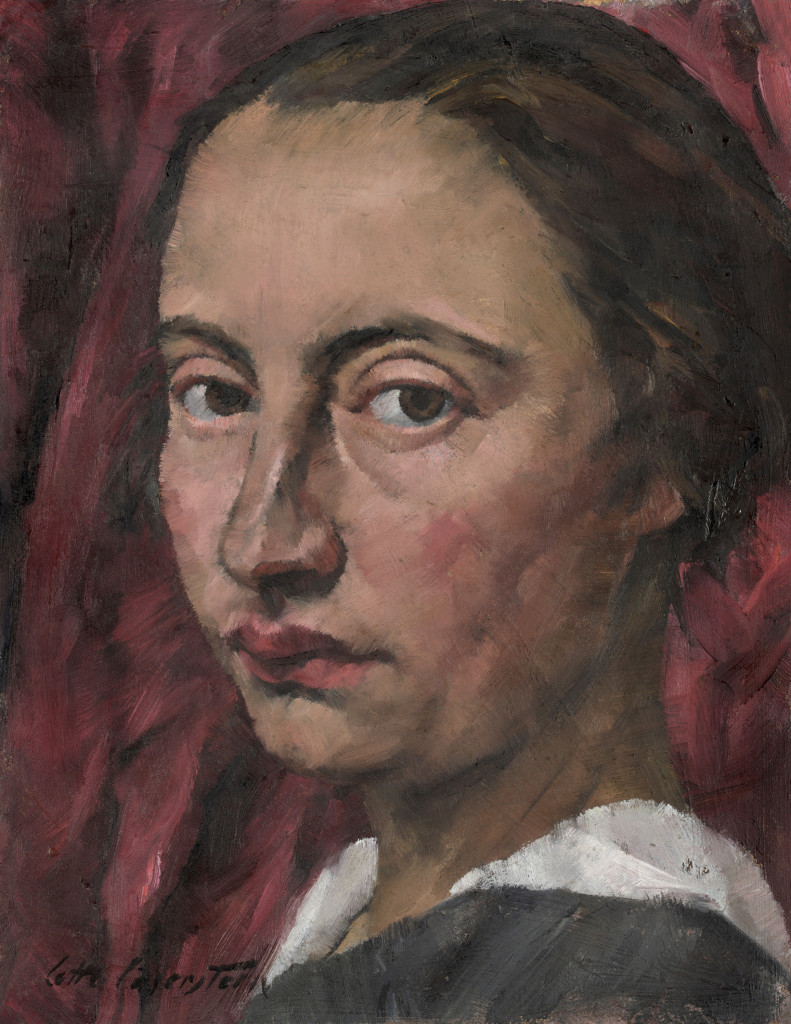Lotte Laserstein (Preussisch Holland, Prussia 1898 - 1993 Kalmar, Sweden)
Self-Portrait before a Red Curtain, 1924-5
Oil on cardboard, 31.5 x 24.4 cm
Signed lower left Lotte Laserstein.
Provenance:
The artist’s estate
Private collection, Sweden
Private collection, Berlin
Exhibited:
Lotte Laserstein, Paintings from Germany and Sweden, 1920-1970, Thos. Agnew & Sons Ltd. and the Belgrave Gallery, London, 1987
Mina minnen och jag [My memories and I], Kalmar, Skälby gård, 1986
Lotte Laserstein 1898-1993. My only reality. Meine einzige Wirklichkeit, exhib. cat., Berlin, Das verborgene Museum e.V. and Stiftung Stadtmuseum, at Museum Ephraim-Palais, and Kalmar, Konstmuseum, 2003-4, p. 357, no. 48, repr. in colour p. 73
Literature:
Anna-Carola Krausse, Lotte Laserstein (1898-1993); Leben und Werk, Berlin 2006,
M 1924/8
Portraits, and self-portraits in particular, occupy a central role in Lotte Laserstein’s œuvre. Her single-minded focus on the genre was rivalled only by her contemporary Max Beckmann. This – described in Anna-Carola Krausse’s catalogue raisonné as a ‘preoccupation with the portrayal of people’[1] – had emerged very early in her career and the teaching of Professor Erich Wolfsfeld (1885-1956) at the Berlin Academy of Art served to strengthen it. Wolfsfeld was a virtuoso draughtsman and he too had a penchant for the same genre. He also maintained a somewhat sceptical attitude towards the avant-garde which Laserstein shared. She was admitted to the Academy in 1921-2 and was a pupil of Wolfsfeld’s for the duration of her studies. In her final two years at the Academy she advanced to become his Meisterschülerin and remained loyal to his teaching.[2] By then she had a studio to work in and a good supply of models and painting materials. However, her financial situation was precarious. In 1925 she was to meet Traute Rose, who would be her close friend and favourite model.
Laserstein won the Academy’s gold medal in 1925. This self-portrait was very probably executed at about the same time. The ductus finds parallels in slightly later works such as the Portrait of an Old Woman (Krausse M 1926/4), and Head of a Young Man (c.1926, Krausse M 1926/2). Stylistically, however, it has little of the softer brushwork and painterly eloquence which she began to develop as a Meisterschülerin.
Two comparable paintings predate the present self-portrait: the unfinished painting titled Self-Portrait with a Headscarf (Krausse M 1923/1) – which recalls Leibl’s Girl with a White Headscarf – and the Self-Portrait with White Collar (Krausse M 1923/2) which is considered Laserstein’s earliest finished self-portrait.[3] In contrast, the present Self-Portrait before a Red Curtain is decidedly more expressive.[4] It is painted using a palette of vibrant colour that heightens the vivacity of her features. Laserstein accentuates a striking physical characteristic of her face, namely what she called her aufgestülpte Oberlippe [protruding upper lip],[5] which she depicts in the same purplish-red as the curtain. This over-hanging lip lends her face a note of determination, perhaps even defiance. Her expression is thoughtful and penetrating.
Laserstein, a Berlin-based 'Neue Sachlichkeit' painter, produced her best work between 1925 and 1933. Independently minded, she rejected conventional norms, perhaps because her unusual lifestyle and her homosexuality stamped her as an outsider. Nevertheless, she was admitted to the Berlin Academy of Art – a rare achievement for a woman. After leaving the Academy she set up a studio in Berlin where she painted and taught. She exhibited widely across Germany and showed three paintings at the 1937 Paris World’s Fair. Part-Jewish, she was forced to leave Germany in 1937 and settled in Sweden. In the war years and later she managed to scrape a living by painting portraits. But like many other exiled artists of her generation, she never succeeded in regaining the international recognition she had once had. Her work was largely forgotten after her death in 1993 but an exhibition at the London fine art dealer Agnew’s in 1987 led to a rediscovery of her oeuvre. Numerous exhibitions at museums and galleries followed. German museums now hold important examples of her work: the Nationalgalerie in Berlin has acquired Evening over Potsdam and the Städel in Frankfurt Russian Girl with Compact.
[1] Krausse, op. cit., p. 54.
[2] Laserstein and Wolfsfeld remained in contact after she left the Academy. She occasionally supplied him with painting materials, particularly after the Nazis seized power in 1933. See Krausse, op. cit., p. 53, note 170.
[3] Laserstein included a tiny self-portrait based on the Self-Portrait with White Collar in the top right corner of a painting titled Grandmother. This self-portrait depicts her as a painter standing in front of a canvas, brush in hand, with her model seated before her. It represents one stage in the development of the final painting. See Krausse, op, cit., pp. 59-60.
[4] Laserstein is likely to have come into contact with Expressionism through her dealings with the
Hungarian-born painter Palo Vido in the early 1920s. The expressive qualities of the present painting reveal certain stylistic parallels with a portrait titled Bobby (Krausse M 1924/9).
[5] See Laserstein’s letter of 1973 to Traute Rose. This describes her rediscovery of the painting titled Self-Portrait with White Collar, cited in Krausse, op. cit., p. 60, note 189: [I have] had an ancient self-portrait framed, c.50 years old. Mouth with protruding upper lip.

